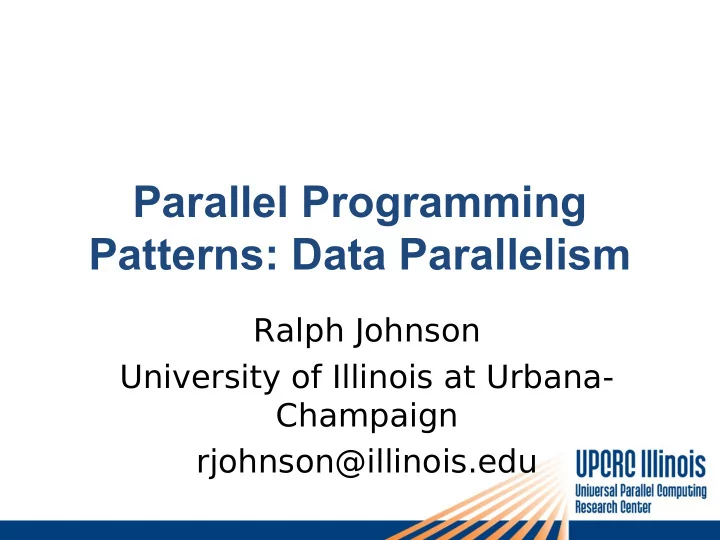

Parallel Programming Patterns: Data Parallelism Ralph Johnson University of Illinois at Urbana- Champaign rjohnson@illinois.edu
www.upcrc.illinois.edu
Pattern language • Set of patterns that an expert (or a community) uses • Patterns are related (high level-low level) www.upcrc.illinois.edu
www.upcrc.illinois.edu
www.upcrc.illinois.edu
Making a pattern language for parallelism is hard • Parallel programming – comes in many styles – changes algorithms – is about performance www.upcrc.illinois.edu
Our Pattern Language • Universal Parallel Computing Research Center • Making client applications (desktop, laptop, handheld) faster by using multicores • Kurt Keutzer - Berkeley • Tim Mattson - Intel • http://parlab.eecs.berkeley.edu/wiki/patterns • Comments to rjohnson@illinois.edu www.upcrc.illinois.edu
The problem • Multicores (free ride is over) • GPUs • Caches • Vector processing www.upcrc.illinois.edu
Our Pattern Language Computational Structural (Algorithms) (Architectural) Algorithm Strategies Implementation Strategies Parallel Execution www.upcrc.illinois.edu
Algorithm Strategies • Task parallelism • Geometric decomposition • Recursive splitting • Pipelining www.upcrc.illinois.edu
Task Parallelism • Communication? As little as possible. • Task size? Not too big, not too small. – Overdecomposition – more than number of cores • Scheduling? Keep neighbors on same core. www.upcrc.illinois.edu
Geometric Decomposition • Stencil www.upcrc.illinois.edu
Geometric Decomposition • Ghost cells www.upcrc.illinois.edu
Recursive Splitting • How small to split? www.upcrc.illinois.edu
Pipelining • Bottleneck • Throughput vs. response time www.upcrc.illinois.edu
Styles of parallel programming • Threads and locks • Asynchronous messaging – no sharing (actors) • Transactional memory • Deterministic shared memory • Fork-join tasks • Data parallelism
Fork-join Tasks • Tasks are objects with behavior “execute” • Each thread has a queue of tasks • Tasks run to completion unless they wait for others to complete • No I/O. No locks. www.upcrc.illinois.edu
void tracerays(Scene *world) { for (size_t i = 0, i>WIDTH, i++) { for (size_t j = 0, j>HEIGHT, j++) { image[i][j] = traceray(i,j,world); } } } www.upcrc.illinois.edu
#include “tbb/parallel_for.h” #include “tbb/blocked_range2d.h” using namespace tbb; class TraceRays { Scene *my_world; Public: void operator() (const blocked_range2d<size_t>& r) { … } TraceRays(Scene *world) { my_world = world; } } www.upcrc.illinois.edu
void operator() (const blocked_range2d<size_t>& r) { for (size_t i = r.rows().begin(), i != r.rows().end(), i+ +) { for (size_t j = j.cols().begin(), j!=r.cols().end(), j++) { output[i][j] = traceray(i,j,world); } } } void tracerays(Scene *world) { parallel_for(blocked_range2d<size_t>(0,WIDTH,8,0,HEI GHT,8), TraceRays(world); } www.upcrc.illinois.edu
• Parallel reduction • Lock-free atomic types • Locks (sigh!) www.upcrc.illinois.edu
• TBB: http://threadedbuildingblocks.org • Java concurrency: http://g.oswego.edu/ • Microsoft TPL and PPL: http://msdn.microsoft.com/concurrency www.upcrc.illinois.edu
http://parallelpatterns.codeplex.com/ 23 www.upcrc.illinois.edu
Common Strategy • Measure performance • Parallelize expensive loops • Add synchronization to fix data races • Eliminate bottlenecks by – Privatizing variables – Using lock-free data structures 24 www.upcrc.illinois.edu
Data Parallelism • Single thread of control – program looks sequential and is deterministic • Operates on collections (arrays, sets, …) • Instead of looping over a collection, perform “single operation” on it • No side effects • APL, Lisp, Smalltalk did something similar for ease of use, not parallelism.
Data Parallelism • Easy to understand • Simple performance model • Doesn’t fit all problems
Operations • Map – apply a function to each element of a collection, producing a new collection • Map – apply a function with N arguments to N collections, producing a new collection
Operations • Reduce – apply a binary, associative function to each element in succession, producing a single element • Select – apply a predicate to each element of a collection, returning collection of elements for which predicate is true
Operations • Gather – given collection of indices and an indexable collection, produce collection of values at indices • Scatter – given two collections, i’th element is element of second collection whose matching element in first has value “i” • Divide – divide collection into pieces 29 www.upcrc.illinois.edu
N-body Body has variables position, velocity, force, mass for time = 1, 1000000 { for b = 1, numberOfBodies { bodies[b].computeForces(bodies); bodies[b].move(); } } 30 www.upcrc.illinois.edu
computeForces(Body *bodies) { force = 0; for i = 1, numberOf Bodies { force =+ forceFrom(bodies[i]) } } 31 www.upcrc.illinois.edu
forceFromBody(Body body) { return mass * body.mass * G / distance(location, body.location) ^ 2 } 32 www.upcrc.illinois.edu
move() { velocity =+ timeIncrement * force / mass position =+ timeIncrement * velocity } 33 www.upcrc.illinois.edu
Data Parallel computeForces map forceFrom to produce a collection of forces reduce with + to produce sum 34 www.upcrc.illinois.edu
Data parallel N-body map computeForces to produce forces map velocity + timeIncrement * force / mass to produce velocities map position + timeIncrement * velocity to produce positions scatter velocities into body.velocity scatter positions into body.position 35 www.upcrc.illinois.edu
TBB/java.util.concurrent/TPL • Each map becomes a parallel loop • In C++ without closures, each parallel loop requires a class to define operator • In Java, large library of operators, else you have to define class 36 www.upcrc.illinois.edu
Messy, why bother? • Data parallelism really is easier • Compiler can vectorize easier • Maps to GPU better • Better support in other languages • Will be better support for C++ in the near future – Intel Array Building Blocks 37 www.upcrc.illinois.edu
Parallel Programming Style • Data parallism – Deterministic semantics, easy, efficient, no I/O • Fork-join tasking - shared memory – Hopefully deterministic semantics, no I/O • Actors - asynchronous message passing - no shared memory – Nondeterministic, good for I/O www.upcrc.illinois.edu
Recommend
More recommend